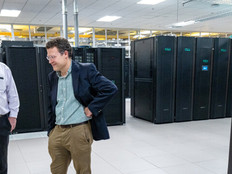The Government Is Becoming A Workforce That’s Never Idle
President Obama has set a goal to eliminate billions of dollars in real estate costs by consolidating or selling off federal properties. Mobile technology is a key factor in helping agencies make progress toward this goal.
By letting workers get their jobs done outside the confines of a traditional office, mobile technology reduces the need for agencies to maintain office space.
Case in point: The General Services Administration is moving thousands of workers from offices around the Washington area to its headquarters at 1800 F Street. Mobile technology is vital to allowing the agency to move more workers into the building than it has desks available. Teleworking and hoteling, enabled by technologies such as smartphones, tablets, notebooks, remote access systems, client virtualization and virtual private networks, will help GSA make efficient use of its workspace, reducing the need for square footage. The agency is able to reduce its real estate footprint as well as its energy needs.
But efficiency is far from the only benefit that mobility brings. Each agency has a mission, and many are finding that mobile technology helps them accomplish that mission with greater speed, accuracy and effectiveness. From Veterans Affairs workers who can bring all the data they need with them as they help homeless vets in the field to Air Force pilots who have replaced flight bags full of unwieldy paper maps with a single tablet device, mobility is improving the way the federal government gets the job done.
Hurdles Remain
But widespread use of mobile computing still faces some obstacles. Many agencies see a divide that has put traditional managers who want to see their workers in the office at odds with employees who may be at their most productive working from home at 2 a.m.
Similarly, workers are finding that remote work can make it more difficult to develop a bond with colleagues. Agencies are looking for a way to emulate the “water cooler effect” among their remote workers, fostering trust and collaboration.
Unified communications technology holds the promise to address both of these concerns. Presence features can let a manager know when workers are at their desks and available for an assignment. Video conferencing can help break down barriers by letting colleagues see a worker’s body language at a meeting, a crucial element given that much communication is nonverbal.
Make the Jump
By integrating UC systems with their employees’ mobile devices, agencies can make a quantum leap, extending the usefulness of both technologies.
The cloud is further enabling this integration. UC systems that run in the cloud can go anywhere a worker has Internet access, providing features such as instant messaging, email, voice and video, collaboration and document sharing.
To meet the needs of their mobile workers, agencies should consider taking their time as they utilize unfamiliar IT tools. Not only can they face cultural resistance from users and managers, but they also must adjust to learning curves, as well as regulations that can increase the degree of difficulty as they implement technology.
Rolling out new capabilities to a small test bed of users, then widening the deployment as users get accustomed to the technology, can reduce the stress of implementation for both users and IT staff. As users become familiar with the new tools, other capabilities can be brought online, expanding the usefulness and increasing productivity.
Once a technology takes hold, the agency may face another challenge: increased expectations. Users who see the productivity increases and efficiency improvements that UC and mobility bring frequently want more.







